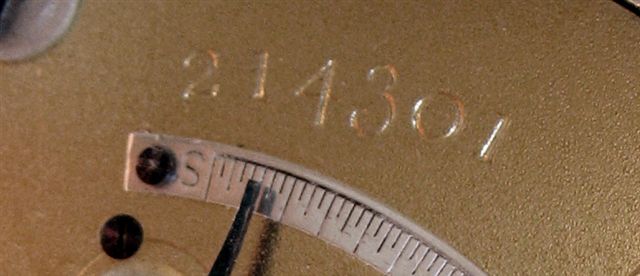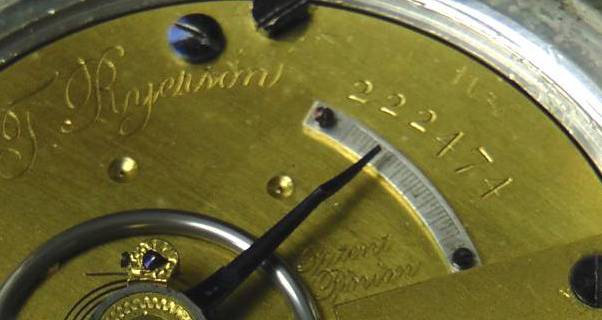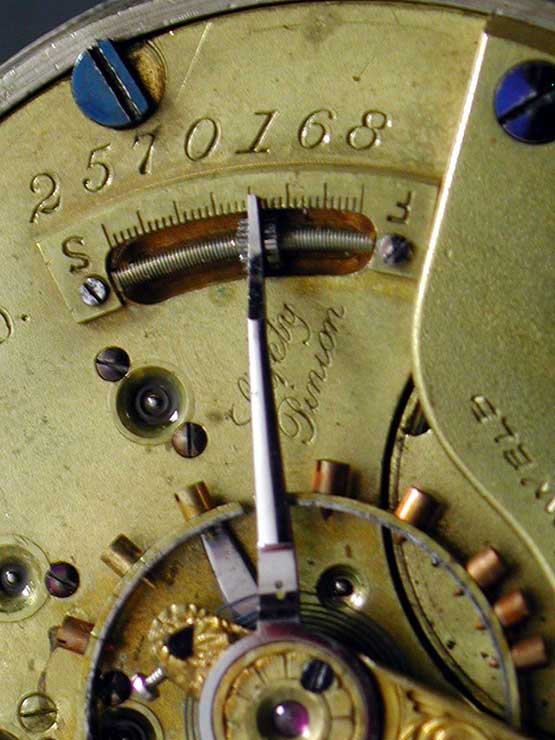
| WWT Shows | CLICK TO: Join and Support Internet Horology Club 185™ | IHC185™ Forums |

|
• Check Out Our... • • TWO Book Offer! • |
Welcome Aboard IHC185™  Internet Horology Club 185
Internet Horology Club 185  IHC185™ Discussion Site Main Page
IHC185™ Discussion Site Main Page  Horological Discussions, Questions and Answers
Horological Discussions, Questions and Answers  Pocket Watch Discussions
Pocket Watch Discussions  Question on Elgin serial number
Question on Elgin serial number
 Internet Horology Club 185
Internet Horology Club 185  IHC185™ Discussion Site Main Page
IHC185™ Discussion Site Main Page  Horological Discussions, Questions and Answers
Horological Discussions, Questions and Answers  Pocket Watch Discussions
Pocket Watch Discussions  Question on Elgin serial number
Question on Elgin serial numberGo  | New Topic  | Find-Or-Search  | Notify  | Tools  | Reply to Post  |  |
I have this early KW W. H. Ferry Elgin. The serial number is 9349 with a small 2 after the first 4 numbers. See picture. Is this a common way of marking serial numbers? Does the small 2 have any significance? | |||
|
| IHC Life Member Site Moderator |
I have seen this before on Elgin pocket watches, sometimes smaller numbers at the front, sometimes in the middle & sometimes at the end. I have never heard a reason for it. The entire set of numbers is the serial number. Tom | |||
|
I've seen this a lot too. On this one, you may notice that grade 55 has many names like RYR, (Joseph T Ryerson) LAF, (Matthew Laflin) FRY (William H Ferry) or none, and have different jewel counts between 7-11J. That may also be a reason? Sheila | ||||
|
First, this is a really nice antique William H.Ferry from early Elgin production in 1869 that I would love to own. Something about these old keywinds that are fascinating. But back to your question... Serial numbers back in the 1860s were hand stamped using a separate die for each number, whether you're talking about Elgin watches or Winchester rifles. The die for most numbers was used so much they broke or were worn down and had to be recut by a tool and die maker up to a dozen times before discarded. Each number's die looks like a metal punch with the raised number on the end. These dies were cut originally in a complete set or "font" of numbers with a definite style all its own. Your serial number font has nice large open numbers for the 9349 stampings, and an entirely different font for the smaller "2". We might guess that the original "2" die that matches the other numbers was broken, or misplaced, or the worker accidentally picked up the wrong "2" from another font--maybe a "2" intended for a smaller size movement. A closer examination of your serial number might show that two different "9" die punches were used--the first "9" die has a little upstroke on the end were the top circle part almost joins the main stem, while the second "9" ends cleanly without the little upstroke. Like Tom, I've got Elgin watches with all kinds of variations in the numbers, but they all are genuine. At least they match the description in Wayne's database, as does the nice old number 93492. Hope this helps. John | ||||
|
Actually, They are exactly the same watch with only 2 difference. One (9349) is dated 1967 and is a LAF, and the other one (93492) was made in 1969, and is the FRY. All other information is about the same. both grade 55, class 5, 7-11J, hfg1ks hunter case, full plate, gold plates, model 1, Key wind, slow train. the runs are 1000 and 4000 of 73095 total What I left off in my last post was, maybe they used an old plate, meant for an earlier LAF, and made it a later Fry and added a 2. John, great information on the fonts. Sheila | ||||
|
Here's the serial number from my H HY Taylor showing 2 large surrounded by 2 smaller numbers. Bob  | ||||
|
| IHC Member 163 |
You wonder what an old machinist sitting at his bench 150+ years ago, punching these numbers onto these watch plates, would think if they knew we'd be pondering this subject today. Regards! Mark | |||
|
Mark, I would guess that they most likely were thinking of something like lunch, or the same things we think of at work, and not a clue that we, in future generations, would even be considering them at all. Then again, although I don't think of future generations that much, I do believe in saving information about watches for the future. My children have strict orders about the ephemra I have collected over the years, and have even helped me to get it organized. John's information about the die's and the fonts is a wonderful example of passing on old methods. It takes you into a whole new world of thought, explains so many questions, and even creates new ones. Great example of the reason for some of the weird numbers, and when you add Wayne's information, it's makes for some great research. Every piece of information makes for some wonderful clues to piece things together huh? Sheila | ||||
|
I'm starting to rethink this. I didn't even consider that Elgin might have stamped 9349 larger on Keith's fine watch, and the small "2" on purpose, but now I think that is the absolute case. Here's another old Elgin from the same series for sale (tonight), serial number 97911, and the last two numbers are printed very small, just like Keith's watch, only in this serial number the last two digits are the same, so BOTH are stamped smaller. Why? I have no idea or even a guess. So now I'm wondering if we can find other examples from this early series? Keywind Elgin #97911 (watch is a mess, wrong dial, wrong case) Here's a photo of the serial number stamping: | ||||
|
| IHC Life Member Site Moderator |
Sheila's answer may be the correct one, as she mentioned on the 1st example 9349 was a Model 4 & 03492 was a model 4. John, 979 was a Model 4 Laflin & 97911 was a Model 4 Model 4 Laflin. So I wonder as Sheila stated that perhaps they had plates left over that they added the extra digits to. I think I have some examples I will look for & see if they fit the same pattern. Tom | |||
|
It's interesting to look at Bob's photo that has the serial number 214301 on his Taylor from 1874, about five years later than Keith's, even though it's a different grade. Bob's watch has the perfect numbers to compare, if you look at the "43" in Bob's, and at the "34" in Keiths. I think these are the same individual die stamped font sizes and style for the "3" and "4" used on both watches. The "9" stamp also looks the same on Keith's and the eBay watch. Then, when I look at the small "2 1" that begins Bob's serial number, they look identical to the same "2" in Keith's watch and "1 1" in the eBay auction one, which come after the larger stamped numbers. It's a smaller font, distinct font for the 2 and 1. And obviously all these numbers were in use over a period from 1869 to 1874, and probably much longer. I still have no idea why the "2" and "1" die stamps are smaller size, regardless of where they appear first in the serial numbers (Bob's) or last in the other two, as shown in our photos. Fun stuff, huh? Tom, hope you can come up with some more examples. I'll go look too at some 18s size Elgin watches from early 1870s. | ||||
|
| IHC Life Member Site Moderator |
Here are a few I have, the one thing I have noticed is I have yet to see the different size numbers on any nickel movements. Tom  | |||
|
Tom, Here's a nickel movement for you. Regards, Bob  | ||||
|
| IHC Life Member Site Moderator |
Thanks Bob, I hadn't seen on like that, not that I have looked hard but non of my nickel ones have different sizes. Tom | |||
|
Is it possible that the department that cut the plates had one die to stamp the series, and the departments that finished them at the other end had another set? Steve G. | ||||
|
Came across this old thread and found it fascinating about the font size of the Elgin serials. From the two older movements I have it seems that they stamp the first few digits ahead of time and then the last digits of that shifts run are done by a different person at the bench. My 1874 movement has the last 3 digits bigger than the first 3. And on my 1887 movement the last 2 digits are smaller than the first 5. So did Elgin know their production runs for that day, or shift and have a bunch of plates stamped ahead of time and then the actual last digits of that sequence are then stamped on the spot? R. Glenn  | ||||
|
Here's the other later movement. At what point did Elgin start to machine stamp their serials? R. Glenn  | ||||
|
| Powered by Social Strata |
| Your request is being processed... |
|
©2002-2025 Internet Horology Club 185™ - Lindell V. Riddle President - All Rights Reserved Worldwide

